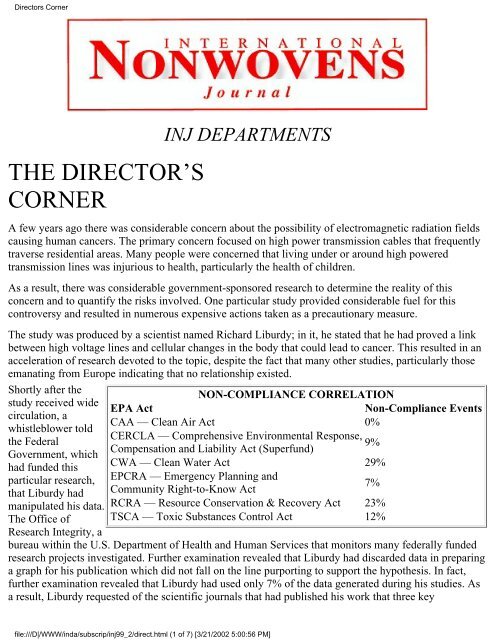1999 - Volume 2 - Journal of Engineered Fibers and Fabrics
1999 - Volume 2 - Journal of Engineered Fibers and Fabrics
1999 - Volume 2 - Journal of Engineered Fibers and Fabrics
You also want an ePaper? Increase the reach of your titles
YUMPU automatically turns print PDFs into web optimized ePapers that Google loves.
Directors Corner<br />
THE DIRECTOR’S<br />
CORNER<br />
INJ DEPARTMENTS<br />
A few years ago there was considerable concern about the possibility <strong>of</strong> electromagnetic radiation fields<br />
causing human cancers. The primary concern focused on high power transmission cables that frequently<br />
traverse residential areas. Many people were concerned that living under or around high powered<br />
transmission lines was injurious to health, particularly the health <strong>of</strong> children.<br />
As a result, there was considerable government-sponsored research to determine the reality <strong>of</strong> this<br />
concern <strong>and</strong> to quantify the risks involved. One particular study provided considerable fuel for this<br />
controversy <strong>and</strong> resulted in numerous expensive actions taken as a precautionary measure.<br />
The study was produced by a scientist named Richard Liburdy; in it, he stated that he had proved a link<br />
between high voltage lines <strong>and</strong> cellular changes in the body that could lead to cancer. This resulted in an<br />
acceleration <strong>of</strong> research devoted to the topic, despite the fact that many other studies, particularly those<br />
emanating from Europe indicating that no relationship existed.<br />
Shortly after the<br />
study received wide<br />
circulation, a<br />
whistleblower told<br />
the Federal<br />
Government, which<br />
had funded this<br />
particular research,<br />
that Liburdy had<br />
manipulated his data.<br />
The Office <strong>of</strong><br />
Research Integrity, a<br />
NON-COMPLIANCE CORRELATION<br />
EPA Act<br />
Non-Compliance Events<br />
CAA — Clean Air Act 0%<br />
CERCLA — Comprehensive Environmental Response,<br />
9%<br />
Compensation <strong>and</strong> Liability Act (Superfund)<br />
CWA — Clean Water Act 29%<br />
EPCRA — Emergency Planning <strong>and</strong><br />
Community Right-to-Know Act<br />
7%<br />
RCRA — Resource Conservation & Recovery Act 23%<br />
TSCA — Toxic Substances Control Act 12%<br />
bureau within the U.S. Department <strong>of</strong> Health <strong>and</strong> Human Services that monitors many federally funded<br />
research projects investigated. Further examination revealed that Liburdy had discarded data in preparing<br />
a graph for his publication which did not fall on the line purporting to support the hypothesis. In fact,<br />
further examination revealed that Liburdy had used only 7% <strong>of</strong> the data generated during his studies. As<br />
a result, Liburdy requested <strong>of</strong> the scientific journals that had published his work that three key<br />
file:///D|/WWW/inda/subscrip/inj99_2/direct.html (1 <strong>of</strong> 7) [3/21/2002 5:00:56 PM]
















